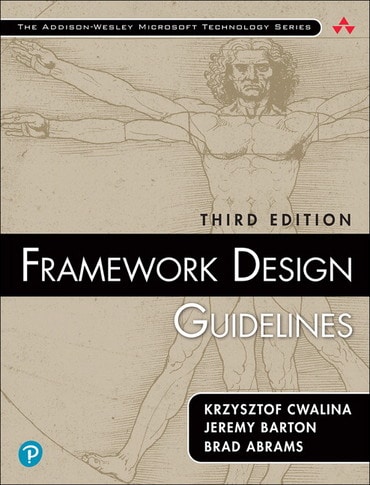Switch content of the page by the Role togglethe content would be changed according to the role

Framework Design Guidelines: Conventions, Idioms, and Patterns for Reusable .NET Libraries, 3rd edition
Published by Addison-Wesley Professional (June 1, 2020) © 2020
- Krzysztof Cwalina
- Jeremy Barton
- Brad Abrams
$61.99
- Available for purchase from all major ebook resellers, including InformIT.com
$61.99
- Available for purchase from all major ebook resellers, including InformIT.com
Title overview
Framework Design Guidelines has long been the definitive guide to best practices for developing components and component libraries in Microsoft .NET. Now, this edition has been fully revised to reflect game-changing API design innovations introduced by Microsoft through eight recent updates to C#, eleven updates to .NET Framework, and the emergence and evolution of .NET Core.
Three leading Microsoft architects share the same guidance Microsoft teams are using to evolve .NET, so you can design well-performing components that feel like natural extensions to the platform. Building on the book’s proven explanatory style, the authors and expert annotators offer insider guidance on new .NET and C# concepts, including major advances in asynchronous programming and lightweight memory access. Throughout, they clarify and refresh existing content, helping you take full advantage of best practices based on C# 8, .NET Framework 4.8, and .NET Core.
Three leading Microsoft architects share the same guidance Microsoft teams are using to evolve .NET, so you can design well-performing components that feel like natural extensions to the platform. Building on the book’s proven explanatory style, the authors and expert annotators offer insider guidance on new .NET and C# concepts, including major advances in asynchronous programming and lightweight memory access. Throughout, they clarify and refresh existing content, helping you take full advantage of best practices based on C# 8, .NET Framework 4.8, and .NET Core.
- Discover which practices should always, generally, rarely, or never be used—including practices that are no longer recommended
- Learn the general philosophy and fundamental principles of modern framework design
- Explore common framework design patterns with up-to-date C# examples
- Apply best practices for naming, types, extensibility, and exceptions
- Learn how to design libraries that scale in the cloud
- Master new async programming techniques utilising Task and ValueTask
- Make the most of the Core Memory
and Span types for lightweight memory access
